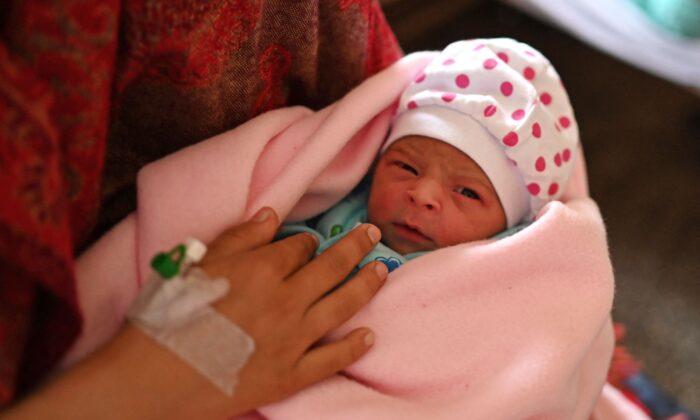Commentary
With an estimated 1.4 billion people, India’s population
has drawn even with China’s, and will soon surpass it, as China’s population is in decline and aging, while India’s is growing and young. A startling 20 percent of people worldwide under the age of 25 live in India.
Environmental alarmists will see nothing in this news for India to celebrate. Obsessed with carbon footprints, low fertility rates have no downsides for them. Some of them boast of their personal decision to forego children as a worthy sacrifice to be emulated by others. These extremists are “
doomographists,” people who believe that the world’s most pressing economic and social problems are linked to procreation.
Story continues below advertisement
Environmental anti-natalism dovetails with a general cultural shift away from interest in marriage and family. A 2021
Pew Research Center survey found that a rising share of U.S. adults who are not already parents say they are unlikely to ever have children, and although some of them cited “the state of the world,” or the environment or financial concerns as their reason, the reason given by a full 63 percent of those aged 18 to 49 is that “they just don’t want to.”
I grew up during the Cold War 1950s in the shadow of “The Bomb.” It was common to hear women vow they would never bring a child into such a volatile and uncertain world. But virtually nobody followed through. The power of the cultural norm—marriage and family—easily triumphed over our entirely reasonable dread. Even couples in straitened circumstances married, choosing to live and procreate in humble conditions, without making home ownership or career security a litmus test for commitment.
Indeed, marriage and family was such a timeless universal paradigm as the basis of society, nobody of my generation could ever have imagined its startling erosion in the last five decades—and not just in the West. The replacement total fertility rate (TFR) is 2.1 live births per woman. Canada’s rate is
at an all-time low of 1.40. The U.S. fertility rate is only slightly better at 1.8. East Asian countries have the world’s lowest TFR: Taiwan’s is 0.98; and Hong Kong’s is 0.87.
Only in Africa is the TFR still high, ranging from 4.7 in Uganda to 6.7 in Niger.
In her 2019 book, “Primal Screams,” cultural critic Mary Eberstadt calls the culturally suicidal trend of deliberate infertility the “Great Scattering.” According to Eberstadt, “loneliness studies” are the hottest trend in sociology. Every year in Japan (TFR 1.4), she writes, some 4,000 elderly Japanese people die without being discovered until the smell of their decomposing bodies alerts their neighbours. Obstetrics in Japan is fading as a profession. In Germany (TFR 1.6), one in four Germans over 70 receives less than a single visit a month by family or friends, and nearly one in 10 receives no visits whatsoever.
A May 2018 Cigna poll cited by Eberhardt found that nearly half of all Americans report “sometimes or always” feeling alone, and that Generation Z—adults then aged 18 to 22—is the loneliest generation of all. Loneliness is sad in itself, but it also has public health implications. Eberstadt cites studies showing a causal link between loneliness and overeating, higher stress levels, cardiovascular conditions, and immune dysfunction. That poll was pre-COVID. The cited symptoms are likely even more concerning today.
Autocratic governments can encourage or even, as with China’s one-child policy, force people to have fewer children, but they have discovered that they cannot do the opposite. Singapore tried. While modernizing in the 1960s after gaining independence from the British, Singapore’s leaders overtly encouraged sterilization and abortion. Maternity leave was denied after two children.
Story continues below advertisement
It worked. Singapore reached its fertility rate target of 2.1 in 1976, a 53 percent plunge over a decade. But as women’s education rates went up, the TFR didn’t stop declining. Singapore reversed their messaging and invested massively in
child care. But no dice. Singapore’s fertility rate in 1960 was 5.45. Today it is 1.1.
A May article in First Things magazine by Scott Yenor, “
Anti-Natal Engineering,” describes a similar process in South Korea, where, into the 1960s, a South Korean woman might give birth to an average of about six children. Marriage rates were very high. Yenor writes: “In 1970, fewer than 2 percent of
Korean women between the ages of thirty and thirty-four were unmarried; today, more than 30 percent are. More than 40 percent of South Koreans below the age of forty
have stopped dating. … in 2020, more than 52 percent of South Koreans in their twenties preferred a childless marriage, up from about 30 percent in 2015.” In fact, South Korea’s fertility and marriage rates “have recently dipped below anything before seen in human history.” The Korea Development Institute
reports that, in 2020, more than 52 percent of South Koreans in their twenties preferred a childless marriage, and more than 30 percent of all Korean households comprise only one person.
What makes these startling statistics especially significant is that the trend was not, as a westerner might assume, linked to feminism or political progressivism. South Koreans remain socially conservative, with clear gender roles and a strong sense of family honour. Feminism in South Korea, Yenor says, “is more an effect of [programmed] anti-natalism than a cause of it.”
As in China and Singapore, the trend was government-led with a view to increasing prosperity. Park Chung-hee, who took power in a military coup in May 1961, wanted women in the work force, and created policies to encourage that end. The government promoted vasectomy and birth control and tripled its family planning bureaucracy. Messaging went from “Three children, three years apart” to “Just have two and raise them well” to “Even two is a lot!”
Story continues below advertisement
The “transformation” was realized, and South Korea went from poor to rich, at the price of fulfilling human connection between the sexes. As fertility rates cratered, the government panicked, and, like Singapore, offered contrary financial inducements plus message reversal—“More than one is twice the fun!”—but too late. Yenor writes that South Korea’s government and elite institutions “systematically dismantled an old, family-centred culture.” Ominously, according to Yenor, relations between the sexes are turning ugly. The result is a culture of barrenness, and, in the words of American cultural observer
Hannah Rosin, writing about East Asia, “industrial-scale sexual indifference.”
I’ve never seen a better case made against the harm done to men and women by well-intended social engineering. But who will listen? Doomography rules the global political roost.
Views expressed in this article are opinions of the author and do not necessarily reflect the views of The Epoch Times.





